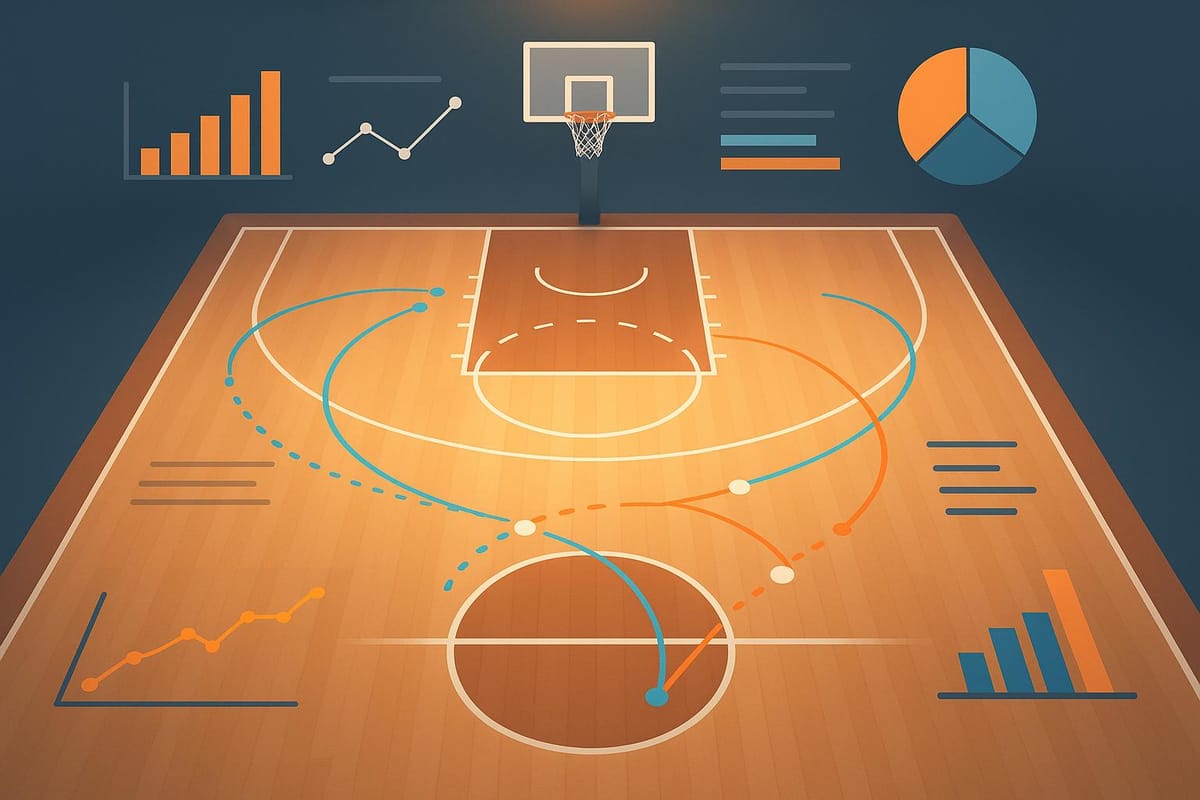10 Essential Sports Analytics Terms Explained
Explore 10 key sports analytics terms that enhance understanding of player performance and team strategy, transforming modern sports analysis.

Sports analytics has redefined how teams, players, and fans understand performance, strategy, and value. This shift from traditional stats to advanced metrics offers deeper insights into player contributions, team strategies, and game outcomes. Here's a quick breakdown of 10 key terms shaping modern sports analysis:
- Player Efficiency Rating (PER): A single number summarizing a basketball player's performance per minute.
- Wins Above Replacement (WAR): Measures how many wins a player adds compared to a replacement-level player in baseball.
- Usage Rate: Tracks how often a basketball player ends a possession (via shot, turnover, or free throws).
- True Shooting Percentage (TS%): Evaluates scoring efficiency by accounting for all shot types.
- On-Base Plus Slugging (OPS): Combines on-base ability and power hitting in baseball.
- Expected Goals (xG): Assesses the quality of scoring chances in soccer or hockey.
- Completion Percentage Over Expected (CPOE): Compares a quarterback’s actual completion rate to expected performance.
- Defensive Box Plus/Minus (DBPM): Estimates a basketball player’s defensive impact.
- Batting Average on Balls in Play (BABIP): Tracks how often batted balls result in hits, excluding home runs.
- Pace: Reflects the speed at which a team or player operates during a game.
These metrics help teams make smarter decisions, from roster building to game strategy, and give fans a better understanding of what drives success in sports.
Advanced Stats in Baseball Explained!
1. Player Efficiency Rating (PER)
The Player Efficiency Rating (PER) boils a basketball player's performance down to a single number. It combines key statistics into one metric, making it easier to compare players at a glance.
While PER gives a snapshot of a player's overall impact, its intricate calculation means it works best when paired with other metrics for a more complete picture. Up next, we'll dive into another key metric widely used in sports analytics.
2. Wins Above Replacement (WAR)
Wins Above Replacement, or WAR, measures how many additional wins a player contributes compared to a replacement-level player - someone like a minor league call-up or a typical bench player. Let’s break down how this metric plays a crucial role in baseball evaluations.
In baseball, WAR serves as a comprehensive tool for assessing a player's overall impact, no matter their position. A player with a WAR of zero is considered replacement level, while a WAR of 2.0 suggests they’ve added two extra wins to their team. For context, everyday starters often post WARs between 1 and 3, while standout players can surpass 5 WAR in a single season.
What makes WAR so useful is its ability to combine a player’s offensive, defensive, and baserunning contributions into one number. This helps teams make smarter roster decisions and explains why some players command higher salaries, even if their traditional stats (like batting average or home runs) don’t seem extraordinary.
That said, WAR isn’t perfect. It depends on estimates - especially for defensive performance - and different organizations might calculate it slightly differently. Because of this, it’s best to view WAR as part of a bigger picture, alongside other important stats.
3. Usage Rate
Usage Rate measures how much of a team's offensive play a player is directly involved in - essentially, it tracks the percentage of plays they impact by ending a possession.
In basketball terms, a possession concludes when a player takes a shot, attempts a field goal, or goes to the free-throw line.
This statistic helps highlight a player's role in shaping the team's offensive approach and strategy.
4. True Shooting Percentage (TS%)
True Shooting Percentage (TS%) measures a player's scoring efficiency by factoring in the varying point values of two-pointers, three-pointers, and free throws. Unlike the basic field goal percentage, TS% acknowledges that not all shots are created equal.
By giving proper weight to each type of scoring opportunity, TS% offers a more accurate picture of a player's ability to turn shot attempts into points. This means players who excel at long-range shooting - where raw field goal percentages might look unimpressive - often shine in this metric, showcasing their true efficiency.
TS% is a simple yet powerful tool in basketball analytics, helping to evaluate how effectively a player scores. Up next, we’ll look at another important statistic that adds even more depth to understanding player performance.
5. On-Base Plus Slugging (OPS)
OPS is a widely used statistic in baseball that combines two crucial aspects of a hitter's performance: their ability to get on base and their power at the plate. By adding together a player's on-base percentage (OBP) and slugging percentage (SLG), OPS provides a well-rounded view of offensive value.
Here’s the formula: OPS = OBP + SLG.
- OBP measures how often a player reaches base via hits, walks, or being hit by a pitch.
- SLG reflects the total bases a player earns per at-bat, with extra weight given to doubles, triples, and home runs.
This combination makes OPS an effective tool for evaluating a player's overall offensive skills. It balances two different strengths: one player might excel at getting on base consistently, while another might be a power hitter who racks up extra-base hits. OPS captures both dimensions in a single number, making it easier to compare players with varying skill sets.
The scale for OPS typically ranges from around 0.500 for struggling hitters to over 1.000 for elite performers. A score of 0.800 or higher is considered above-average, while anything over 0.900 signals an outstanding offensive player. Baseball legends often boast career OPS numbers exceeding 0.950.
What makes OPS especially appealing to analysts is its simplicity and depth. Unlike batting average, which values all hits equally, OPS recognizes that a home run is far more impactful than a single. It also rewards players who draw walks and show strong plate discipline. This makes it a go-to metric for assessing offensive contributions quickly and effectively.
Beyond individual performance, OPS plays a significant role in shaping team decisions. It’s often used to evaluate player contracts, assess trade value, and optimize lineups. Next, we’ll dive into another metric that sharpens offensive analysis even further.
6. Expected Goals (xG)
Expected Goals (xG) is a metric in soccer analytics that evaluates the likelihood of a shot resulting in a goal. Unlike simply counting shots or goals, xG assigns a probability to each attempt based on historical data and various factors that influence scoring chances.
The calculation of xG typically considers elements like shot location, angle, and the type of pass leading to the attempt. This approach offers a more nuanced way to understand the quality of scoring opportunities, going beyond surface-level stats.
Teams and analysts use xG to compare the number of actual goals scored to the quality of chances created. Over time, this comparison helps uncover patterns in finishing accuracy and defensive effectiveness, offering a richer understanding of a team's performance in matches.
7. Completion Percentage Over Expected (CPOE)
Completion Percentage Over Expected (CPOE) measures how a quarterback's actual completion percentage stacks up against what would be expected given the game conditions. Since there isn't a universally accepted formula for calculating it, different teams and analysts interpret it in their own ways. As football analytics continue to develop, a more consistent method may eventually take shape.
8. Defensive Box Plus/Minus (DBPM)
In basketball analytics, plus/minus stats help assess how a player influences the game while they're on the court. Defensive Box Plus/Minus (DBPM) focuses specifically on a player's defensive contributions in relation to their team's overall performance.
Unlike some other advanced metrics, DBPM isn't as widely standardized. However, it serves as a valuable tool for teams looking to assess defensive performance. By providing a different angle, it complements offensive and overall impact statistics, giving a more rounded view of a player's game.
9. Batting Average on Balls in Play (BABIP)
BABIP tracks how often batted balls result in hits, offering insight into both hitters' performance and pitchers' results. This stat can be swayed by factors like defensive positioning and pure luck, making it more meaningful when considered alongside other metrics.
Up next, we'll dive into how pace impacts the flow of the game.
10. Pace
Pace is all about the speed at which a team or player operates during a game. It’s a key metric that sheds light on game tempo, offering valuable insights for crafting strategies, managing players, and understanding the overall flow of play.
In basketball, pace is typically calculated by looking at the number of possessions a team has during a standard game, often normalized to 48 minutes. For elite teams, this statistic serves as a critical performance indicator, helping them gain an edge over their competition.
But why does pace matter so much? For one, it plays a big role in load management. By analyzing pace, coaches can fine-tune training sessions and game strategies to match each player’s optimal work rate. As KINEXON Sports puts it:
"Load metrics will define overall volume for your players, define their work rate and pace of play. You'll be able to match game intensity in practice."
Pace tracking isn’t just for the pros - it’s a game-changer for youth development, too. Monitoring how young players handle different tempos helps coaches guide them in building endurance, improving decision-making, and lowering the risk of injuries.
When combined with other performance metrics, pace provides teams with a fresh perspective on optimizing their play. It’s not just a tool for managing game flow - it’s a window into strategic opportunities and player dynamics that traditional stats might miss.
Quick Reference Table
Here’s a quick overview of key sports metrics, their definitions, and how they’re applied across different sports and team strategies.
| Term | Definition | Primary Sports | Team Applications |
|---|---|---|---|
| Player Efficiency Rating (PER) | Measures a player’s per-minute performance across various stats | Basketball (NBA) | Guides roster decisions and salary discussions |
| Wins Above Replacement (WAR) | Evaluates a player’s value compared to a replacement-level player | Baseball (MLB) | Used for free agency evaluations and trade decisions |
| Usage Rate | Tracks the percentage of team plays a player uses while on the court | Basketball (NBA) | Shapes offensive strategies and player roles |
| True Shooting Percentage (TS%) | Accounts for shooting efficiency, including free throws and three-pointers | Basketball (NBA) | Helps analyze shot selection and offensive systems |
| On-Base Plus Slugging (OPS) | Combines on-base ability and power-hitting into one stat | Baseball (MLB) | Assists in lineup optimization and scouting |
| Expected Goals (xG) | Assesses scoring chance quality based on shot location and context | Soccer, Hockey | Enhances tactical analysis and performance reviews |
| Completion Percentage Over Expected (CPOE) | Compares a quarterback’s actual completion rate to the expected rate | Football (NFL) | Evaluates quarterbacks and informs play-calling strategies |
| Defensive Box Plus/Minus (DBPM) | Estimates defensive contributions in points per 100 possessions | Basketball (NBA) | Aids in defensive planning and contract assessments |
| Batting Average on Balls in Play (BABIP) | Measures hit rates on balls in play (excluding home runs) | Baseball (MLB) | Differentiates luck from skill in player performance |
| Pace | Reflects the speed of play based on possessions or plays per game | Basketball | Influences game strategies and player fitness plans |
These metrics highlight how data shapes modern sports strategies. By combining multiple analytics, teams can make smarter decisions on player evaluations, tactical planning, and roster construction. This interconnected approach to data isn’t just about individual stats - it’s about seeing the bigger picture and using it to gain a competitive edge.
Conclusion
Understanding these 10 key terms can transform the way you approach sports analytics. Whether you're diving into LeBron James' PER in the NBA, assessing Aaron Judge's WAR in MLB, or breaking down Patrick Mahomes' CPOE in the NFL, these metrics are essential tools for meaningful sports discussions.
These concepts work together to give a more complete picture. For example, pairing Usage Rate with True Shooting Percentage or comparing BABIP with OPS can provide deeper insights into a player’s overall impact on the game.
For teams and analysts, these metrics are more than just numbers - they’re decision-making tools. Platforms like StatPro simplify the process by delivering real-time data for the NFL, NBA, and MLB. This way, you can focus on interpreting the data rather than spending time collecting it, helping you uncover valuable insights into player performance and team strategies.
As you explore the world of modern sports analytics, incorporating these metrics will elevate your understanding of what makes teams and players excel. They serve as a bridge between traditional scouting methods and the ever-growing influence of data-driven analysis, ensuring you stay ahead in the game.
FAQs
How do sports teams use metrics like Wins Above Replacement (WAR) and Player Efficiency Rating (PER) to guide their strategies?
Sports teams use metrics like Wins Above Replacement (WAR) and Player Efficiency Rating (PER) to evaluate player performance and guide their decision-making.
WAR measures how much value a player adds to their team compared to a replacement-level player. This helps teams pinpoint top performers and decide how to best allocate their resources.
Meanwhile, PER focuses on a player's efficiency per minute on the court. It takes into account positive contributions, such as scoring and assists, while also factoring in negatives like turnovers.
By leveraging these metrics, teams can fine-tune their lineups, spot undervalued talent, and craft strategies to boost overall performance.
What are the drawbacks of using metrics like True Shooting Percentage (TS%) and Batting Average on Balls in Play (BABIP) to evaluate players?
Metrics like True Shooting Percentage (TS%) and Batting Average on Balls in Play (BABIP) can offer helpful insights, but they come with their own set of limitations when it comes to evaluating players.
TS% zeroes in on scoring efficiency, which is valuable, but it leaves out key aspects of a player’s game like defense, playmaking, and rebounding. Relying solely on this metric can paint an incomplete picture of how much a player truly contributes to their team.
BABIP, on the other hand, is often shaped by factors outside a player’s control - things like defensive positioning and sheer luck. Because of this, it doesn’t always provide a clear reflection of a hitter’s true abilities. To get a more well-rounded assessment, these metrics should be paired with others that capture a broader range of performance elements.
How do advanced metrics like Expected Goals (xG) and Completion Percentage Over Expected (CPOE) help us better understand team performance in sports like soccer and football?
Advanced metrics like Expected Goals (xG) and Completion Percentage Over Expected (CPOE) provide a more nuanced look at team performance by focusing on the quality of plays rather than just the final results. Take xG, for instance - it estimates the probability of a goal being scored based on factors such as the angle and distance of a shot. This helps paint a more accurate picture of a soccer team's offensive efficiency. On the other hand, CPOE evaluates a quarterback's performance by comparing actual completion rates to what’s expected, factoring in the difficulty of passes and defensive pressure.
These metrics go beyond basic stats, helping teams and analysts uncover hidden strengths, pinpoint weaknesses, and spot opportunities that might otherwise be missed. This leads to sharper strategies and smarter player evaluations.




